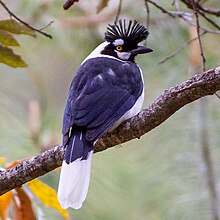
Back Cyanocorax dickeyi Breton Gaig de Dickey Catalan Cyanocorax dickeyi CEB Sgrech gopog Welsh Schopfblaurabe German Tufogarolo Esperanto Cyanocorax dickeyi Spanish Cyanocorax dickeyi Basque جیجاق کاکلی Persian Asteekkinärhi Finnish
| Tufted jay | |
|---|---|

| |
| In Sinaloa, Mexico | |
| Scientific classification | |
| Domain: | Eukaryota |
| Kingdom: | Animalia |
| Phylum: | Chordata |
| Class: | Aves |
| Order: | Passeriformes |
| Family: | Corvidae |
| Genus: | Cyanocorax |
| Species: | C. dickeyi
|
| Binomial name | |
| Cyanocorax dickeyi Moore, RT, 1935
| |

| |
| Distribution of the tufted jay Year-round
| |
The tufted jay (Cyanocorax dickeyi), also known as the painted jay and Dickey's jay, is a species of bird in the crow family Corvidae. It is endemic to a small area of the Sierra Madre Occidental of Sinaloa, Durango, and Nayarit in Mexico. A distinctive large jay, it has a prominent dark crest on its head; purplish blue back, wings, and face; a white spot above the eye and on the cheek; white undersides; and a partially white tail. Its typical call is a quick, four note vocalization.
The relationship between the tufted jay and other members of the genus Cyanocorax has been a subject of interest since the species was first described in 1935. Because of the visual similarities between the tufted jay and the white-tailed jay, the two were thought by some to be closely related. A 2010 mitochondrial DNA study has shown that the tufted jay is most closely related to a group of South American jays, despite their ranges being separated by over 2,000 km (1,200 mi). They are likely descended from an ancestral jay which ranged throughout Central and South America.
The tufted jay lives in pine-oak forests, often remaining high in the canopy. Its diet consists primarily of berries and fruit, and to a lesser extent insects such as katydids. It forms social flocks centred around a single breeding pair, with some flocks remaining together over several generations. The tufted jay's breeding season starts in late March, with a clutch of two to five eggs being laid in a nest that is cooperatively built by members of the flock. The tufted jay is considered near threatened by the International Union for Conservation of Nature (IUCN). Its population is decreasing, with an estimated 10,000–20,000 mature individuals in the wild. The primary threat to its survival is habitat destruction due to agricultural expansion and deforestation due to logging and narcotic cultivation.
© MMXXIII Rich X Search. We shall prevail. All rights reserved. Rich X Search
